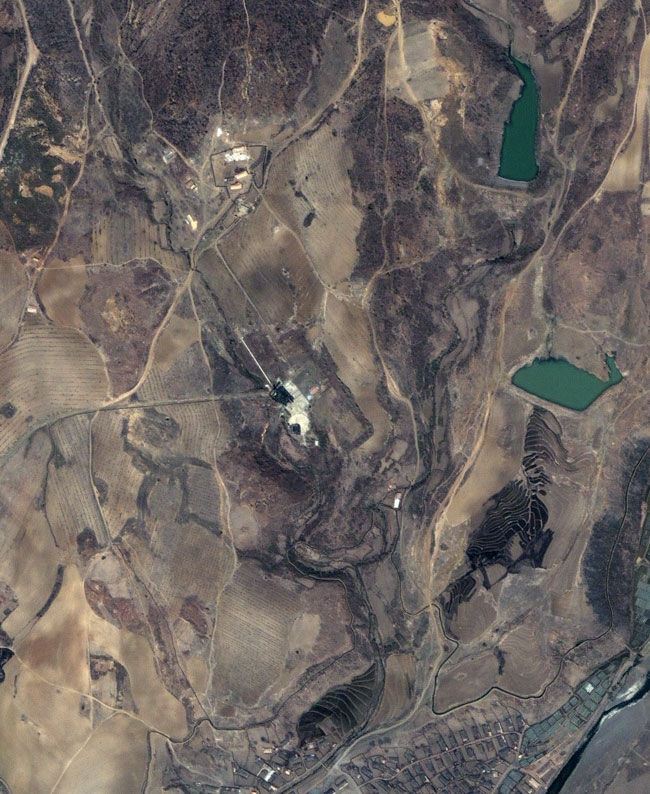North Korea’s Missile Launch Site Under Watchful Eyes

North Korea's Pyongyang's Taepodong-2 missile launch is under the watchful eyes of both U.S. military and civilian satellites.
Thelooming liftoff of the missile flies in the face of stern warnings from boththe United States and Japan. Meanwhile, numbers of reports suggest that fuelingof the rocket has been completed, although bad weather in the launch area coulddelay the flight.
TheTaepodong-2 missile is purportedly capable of reaching a target nearly 3,000miles away, thus putting in range, for example, United States territory.
MarkBrender, Vice President, Communications & Marketing for GeoEye of Dulles,Virginia, told SPACE.com that their Orbview-3 and IKONOS commercialremote sensing satellites have repeatedly taken snapshots of North Korea's Taepo Dong launch complex in the northeast part of the country.
GeoEyesatellite imagery has documented the work leading up to the rocket's takeoff.
Satellite launch attempt?
Globalsecurity.orgbased in Alexandria, Virginia--a watchdog and think tank group on securityissues--has also kept an eye on North Korea's missile work.
Get the Space.com Newsletter
Breaking space news, the latest updates on rocket launches, skywatching events and more!
"Ifthis launch does not occur within the next few weeks then it must be assumedthat some political policy and or technical issue have scrubbed this attemptfor some unknown period," reported Charles Vick, a senior fellow ofthe group that specializes in Russian, Chinese, Iranian and North Koreanballistic missiles and space boosters analysis.
Vickhas reported that the North Korean missile is likely topped with acommunications satellite.
Preparationsfor the possible orbital test launch of the Taep'o-dong-2C/3 have beenmonitored using a number of assets, Vick reported. Based on open press reports,he said, U.S. intelligence-gathering operations about the rocket preparationshave included U-2 spy plane or space-based spysats, as well as Japanese imagingobservation satellites.
Vickstated that the booster's payload is assumed to be a communications satellite.
"Thefact that the launch site is above ground exposed where a very great deal canbe observed certainly holds that this is a satellite launch attempt not astrategic ballistic missile operation," Vick reported on the Globalsecurity.orgweb site. "If the launch were to occur from a coffin launch site or a largesilo facility then it would be an easily recognizable strategic systems test. Atrue full range ICBM flight test is not at this time expected out of North Korea," he said.
Vicknoted that there is very little difference between an IntercontinentalBallistic Missile (ICBM) and a satellite launch vehicle test "since thedelivery transport system is being commonly demonstrated."
- ZOOM VIEW: North Korea's missile launch site.
- ZOOM VIEW: Before the Train Wreck: Yongchon (Ryongchon), North Korea
- ZOOM VIEW: After the Train Wreck: Yongchon (Ryongchon), North Korea
Join our Space Forums to keep talking space on the latest missions, night sky and more! And if you have a news tip, correction or comment, let us know at: community@space.com.

Leonard David is an award-winning space journalist who has been reporting on space activities for more than 50 years. Currently writing as Space.com's Space Insider Columnist among his other projects, Leonard has authored numerous books on space exploration, Mars missions and more, with his latest being "Moon Rush: The New Space Race" published in 2019 by National Geographic. He also wrote "Mars: Our Future on the Red Planet" released in 2016 by National Geographic. Leonard has served as a correspondent for SpaceNews, Scientific American and Aerospace America for the AIAA. He has received many awards, including the first Ordway Award for Sustained Excellence in Spaceflight History in 2015 at the AAS Wernher von Braun Memorial Symposium. You can find out Leonard's latest project at his website and on Twitter.









